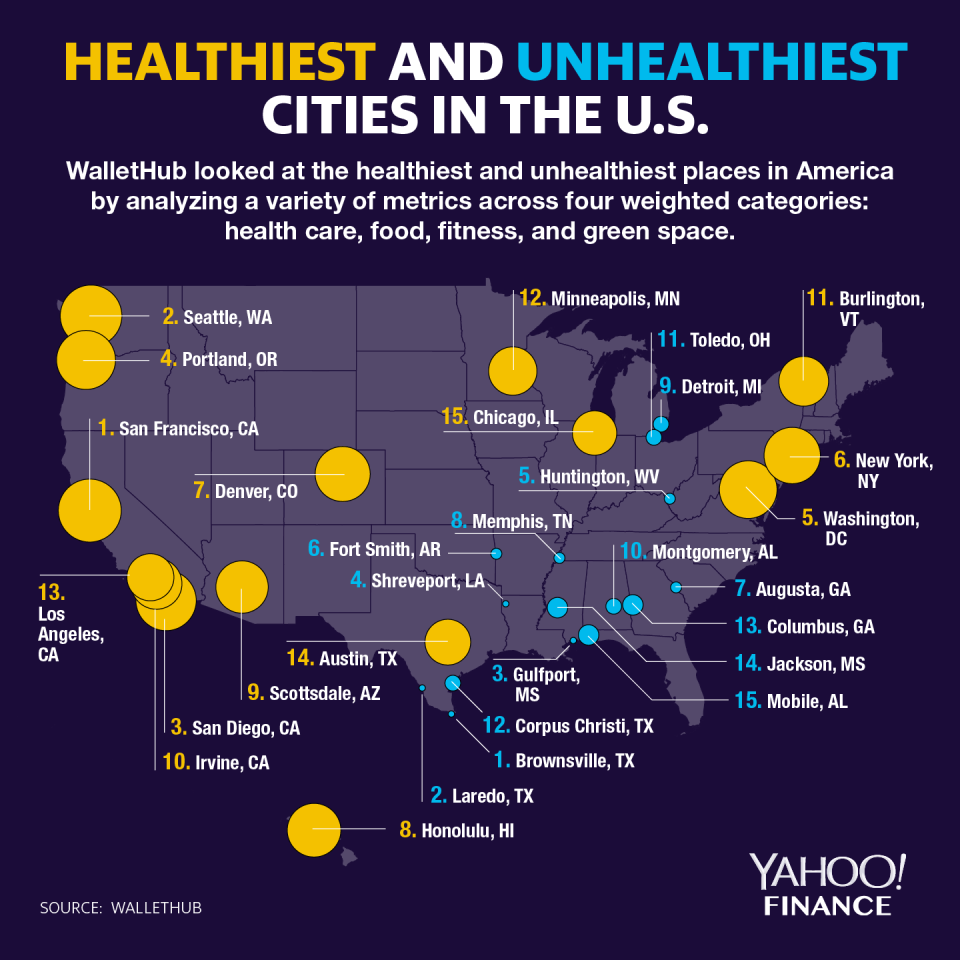These are the healthiest and unhealthiest U.S. cities
The West Coast is home to some of the healthiest cities in America.
According to a study from WalletHub, San Francisco is the healthiest city in the U.S., followed by Seattle, San Diego, Portland, and Washington, D.C.
WalletHub calculated the data by comparing 174 cities across four weighted dimensions: health care, food, fitness, and green space.

One of the factors was the lowest premature death rate. Nearly all of the top cities are located in California, much like the percentage of adults eating enough fruits/vegetables per day.
The West Coast also has the highest percentage of physically active adults. This may be why San Francisco took the top spot — it has the most walking trails per capita and the most running trails per capita.
The South contains most unhealthy cities
Meanwhile, the unhealthiest cities in the U.S. are overwhelmingly found in the South. Brownsville, Texas, is the least healthy spot in the nation and two other Texas cities made the list, along with two in Alabama, two in Georgia, and two in Mississippi.
“Those states in particular have high [obesity] rates, and I’m sure their physical activity is rather low,” Dr. Charles Platkin, the director of the Hunter College NYC Food Policy Center and editor of DietDetective.com, told Yahoo Finance.
“It’s cultural … around food and eating. Probably a more relaxed atmosphere, more rural in some of the urban centers. Hence the high levels of walkability or concerns about healthy eating or concerns about lifestyle. Whereas in those states, they have higher levels of blue collar workers.”

Access to health care is also important. Laredo, Texas, the second-most unhealthy city, is among the places with the fewest mental health counselors per capita and the fewest healthy restaurants per capita. It also has a low percentage of physically active adults.
“My wife’s family is from a small town in Kentucky,” Platkin added. “They have dentists that come in once a year, medical services, and they set up a health fair. So there’s not a lot of access to medical care like you’d have in a big urban center. I think the rural environment, lack of access to medical and mental care, all of this is probably why they’re lower on the low end of this scale because that was a significant part of it.”
‘Eating healthy can ... be a luxury’
Several of these states have some of the highest poverty levels in the nation. Poverty plays a bigger role in health than many realize, Platkin explained.
“When there’s high levels of poverty, there are more than likely high levels of food insecurity and hunger-related issues,” he said. “You think ‘oh well, if they’re food insecure and they’ve hunger issues, we’ll all be thin, right?’ No, that’s not the case, actually. It’s counterintuitive in some ways, because you tend to just eat what you can.”
Corpus Christi, Texas, no. 12 among unhealthiest cities, has some of the fewest healthy restaurants per capita and the highest percentage of adults not eating enough fruits and vegetables per day.
“Eating healthy can sometimes in the United States, believe it or not, be a luxury and it shouldn’t necessarily be a luxury,” Platkin said. “To us, when we talk about food and food insecurity, we see the right to healthy, inexpensive food as a human right, but it’s not in a lot of instances.”
Adriana is an associate editor for Yahoo Finance. Follow her on Twitter @adrianambells.
READ MORE:
Millions of Americans with employer health care are still spending a fortune
'Everyone’s health insurance is more expensive' as more Americans manage chronic diseases
'A vicious cycle': High rent is keeping Americans from health care
Read the latest financial and business news from Yahoo Finance
Follow Yahoo Finance on Twitter, Facebook, Instagram, Flipboard, SmartNews, LinkedIn, YouTube, and reddit.
